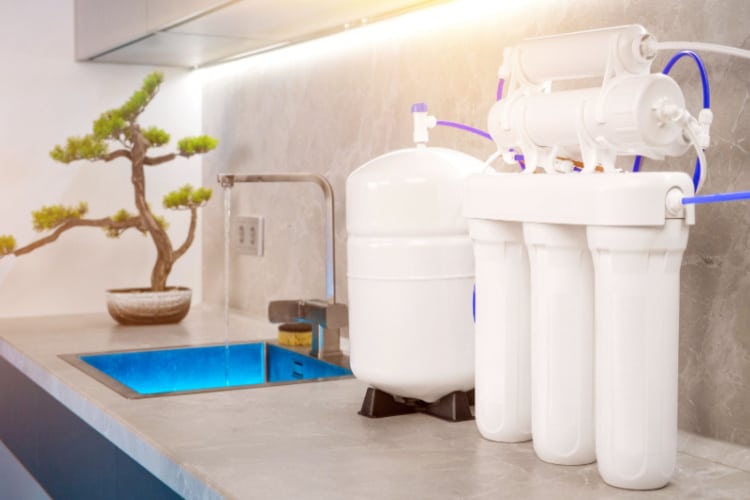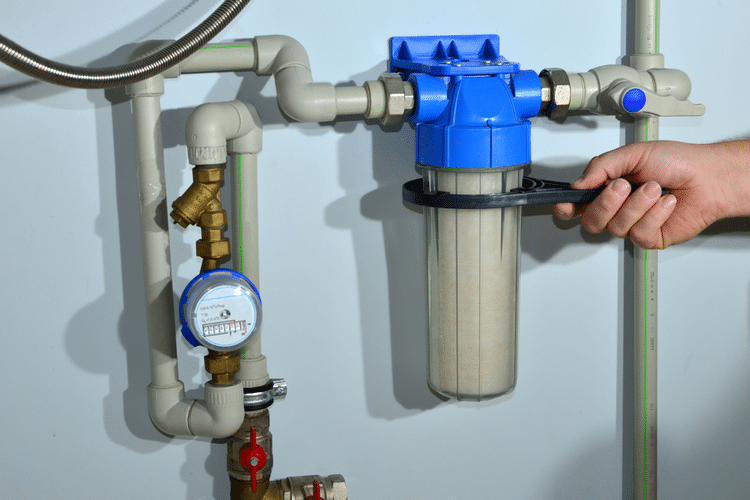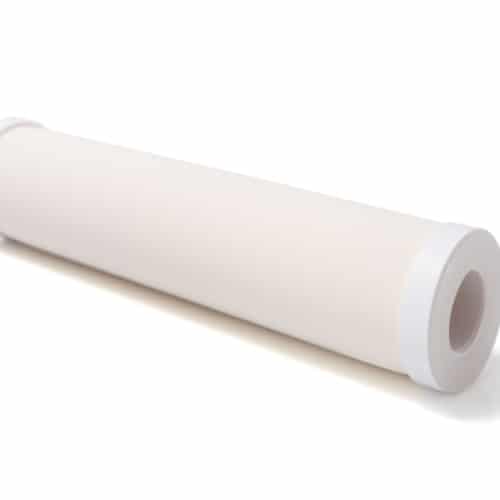If you own a reverse osmosis system, you might be concerned about the demineralization of water. It’s a proven fact that the RO process removes more than 90% of both beneficial and harmful minerals.
But, why does reverse osmosis remove healthy minerals from drinking water? Healthy minerals are removed because the semi-permeable membrane of an RO system traps particles larger than water molecule.
Since most minerals are bigger than water molecules, they also get trapped and filtered out by the membrane.

Reverse Osmosis Removes Minerals
Reverse osmosis removes 90 – 99.9% of contaminants and minerals such as calcium, magnesium, potassium, copper, zinc, sodium, and phosphorus from drinking water.
Check out the table below for healthy water minerals & their benefits:
How Minerals are Removed During the RO Process
| Mineral | Benefits |
|---|---|
| Calcium | Maintains the taste and hardness of the water. Essential for bone and teeth development |
| Magnesium | Supports weight management, plays a key role in food to energy conversion |
| Potassium | Balances body fluid, supports complex body organs |
| Phosphorus | Helps in bones and teeth formation |
| Sodium | Adds alkaline taste to the water, balances water and mineral levels in the body |
| Copper | Improves the bone formation, nervous system, blood, and metabolism |
| Zinc | Boosts the immune system and helps in blood function |
Reverse osmosis systems feature a unique RO membrane with tiny pores of 0.0001 microns that effectively filter out water contaminants and minerals. Usually, the size of dissolved components in supply water ranges from 5 microns to 1 micron.
City water supply in most areas contain a large amount of inorganic and organic components derived from soil and rocks. Among these components, some are essential minerals, while others are harmful and toxic to the human body.
Reverse osmosis systems use multiple filters to remove all these healthy and harmful components from water. Here’s how the RO process removes minerals:
- The RO system reverses the osmosis process (natural tendency of water to flow towards higher salt concentrations) using a powerful pump. Inside the RO system, the pump forces water through multiple filters to separate the impurities and dissolved components.
- Usually, most reverse systems have three filtering cartridges. The first one is a sediment filter that separates larger contaminants. As the mineral molecules have a diameter of 1 micron or less, this filter doesn’t separate healthy or unhealthy minerals.
- The second filter is an activated carbon filter that removes thinner particles like lead, chlorine chemicals, etc. This filter won’t remove most minerals.
- Then, the water passes through the last and most effective filter, the semi-permeable RO membrane. While other regular filters only separate molecules up to 1-micron diameter, the RO membrane can remove molecules as small as 0.0001 microns!
- Since most minerals have a 1-micron diameter, the tiny pores of the RO membrane can easily filter them out during the reverse osmosis process.
Is It Possible to Stop The Removal of Minerals?
Yes, it’s possible to stop the removal of minerals if you separate the RO membrane from your reverse osmosis system. However, you must remember that the reverse osmosis system will become like any regular water purifier without this special filter. The sediment and carbon filters can only remove contaminants as small as 5 microns.
This means microscopic viruses and some harmful contaminants won’t be filtered from the water. If you are ready to discount this health risk, you can remove the reverse osmosis membrane to maintain the optimum amount of essential minerals in filtered water.
Can The Minerals Be Added Back?
Yes, recent RO systems can add stripped minerals back to the filtered water. Some include an alkaline filter to add a measured amount of healthy minerals to the water. On the other hand, many feature dedicated filters that make the water alkaline.
You can also remineralize the filtered water by adding drops of minerals. We recommend adding an alkaline filter to the RO system. It doesn’t affect the performance of the RO membrane while effectively adding essential minerals to the water.
Other RO Alternatives That Don’t Remove Minerals
The most efficient substitutes for Reverse Osmosis include Biocompatible water filtration, Ultrafiltration, Carbon block filtration, and Ceramic filtration.
1. Biocompatible Water Filtration
Biocompatible water filtration involves 14 stages of filtration. It removes all types of impurities from water, including lead, fluoride, chlorine, pesticides, chromium-6, industrial residues, etc. The system combines deionization and reverse osmosis stages to give you clean water.
While the first seven stages remove toxins and impurities, the last seven stages eliminate germs and add minerals to maintain water’s purity and natural taste. It’s easily one of the best filtration systems available today.
2. Ultrafiltration
Ultrafiltration is efficient in disinfecting tap water without eliminating minerals. It removes 99.9% of bacteria, protozoa, and viruses from water. Another benefits is that it offers zero waste water and runs without electricity.

3. Carbon Block Filtration
Carbon block and activated carbon filtration are the best technology for eliminating industrial chemicals, pesticides, and herbicides.

These filters remove pathogens, chlorine, toxins, heavy metals, and other contaminants from water. However, carbon filters aren’t as effective as reverse osmosis, and you’ll need a filter attachment to remove fluoride from tap water.
Yet, carbon filters are a cheaper option to get clean water with healthy minerals.
4. Ceramic Filtration
Another low-cost purifier option that retains minerals in refined water is the ceramic filtration system. It can effectively eliminate bacteria and protozoa from water.

Also, ceramic filters have been proven helpful in reducing diarrhea-causing pathogens. However, it doesn’t remove chlorine and some microscopic viruses.